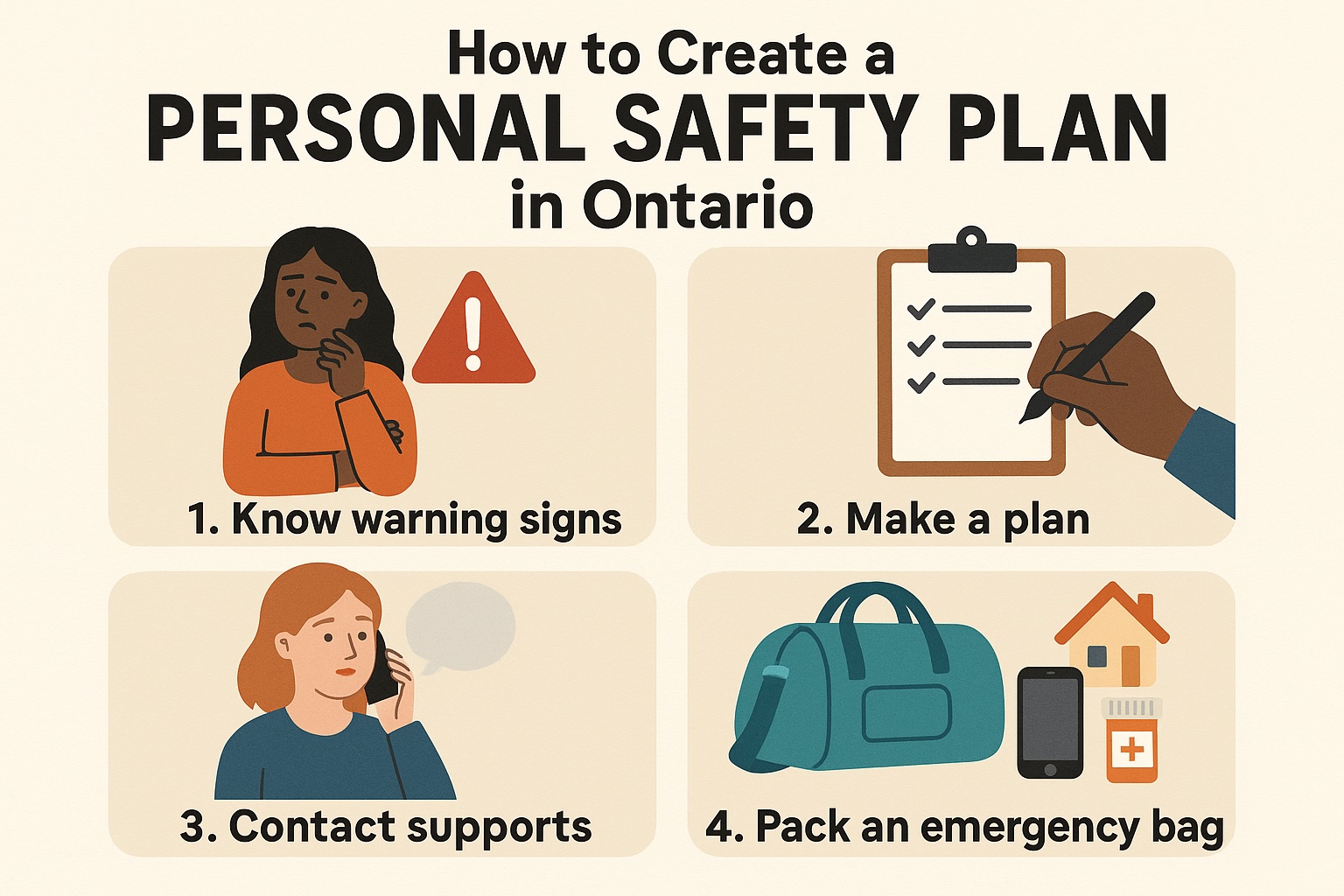How to Create a Personal Safety Plan in Ontario
Worried about your safety at home? A personal safety plan can help you prepare for dangerous situations. Learn how to build one—step-by-step—with tips specific to Ontario.

If you’re living with abuse or feel unsafe at home, having a personal safety plan can help you protect yourself and your children. A safety plan is a custom guide that prepares you for emergencies, helps you leave safely, and ensures access to help when you need it most.
❗ Why You Need a Safety Plan
-
Abuse can escalate without warning
-
You may not have time to think clearly during a crisis
-
A written or mental plan helps you act quickly and stay safe
-
It gives you control and confidence—even in high-stress moments
📝 What to Include in Your Safety Plan
🔑 Emergency Exit Plan
-
Identify at least 2 safe ways out of your home (doors, windows, stairwells)
-
Keep your keys, wallet, ID, and phone in an easy-to-grab place
-
Teach your children how to exit and where to meet
-
Avoid rooms with weapons or no exits during conflict (like kitchens or bathrooms)
👜 Essentials Bag (Hide or Store with a Trusted Person)
-
Government ID, health cards, immigration papers
-
Prescription medications
-
Birth certificates for you and children
-
Emergency cash or prepaid debit card
-
Extra clothing, keys, and a charger
-
A list of important phone numbers
📞 Safe Contacts
-
Choose 2–3 trusted people you can call in an emergency
-
Practice code words for children, friends, or coworkers to signal danger
-
Know which hotlines to call (e.g., Assaulted Women’s Helpline: 1-866-863-0511)
🧠 Emotional Safety Plan
-
Identify places or people who feel safe
-
Plan how you’ll care for your mental health (journaling, breathing, support groups)
-
Recognize triggering situations and how to de-escalate or escape
-
Work with a counsellor or shelter staff to build trauma-informed coping tools
👩👧 Planning with Children
-
Teach kids how to dial 911 and give your address
-
Practice safety drills if age-appropriate
-
Identify who they can trust (neighbour, teacher, relative)
-
Reassure them that abuse is never their fault
🏢 At Work or School
-
Let HR or security know if there’s a protection order
-
Give a photo of your abuser (if safe to do so)
-
Vary your routes and routines
-
Arrange backup transportation if you need to leave suddenly
🏘️ After Leaving or Getting a Restraining Order
-
Change locks, passwords, and phone numbers
-
Inform schools, daycare, doctors, and neighbours
-
Ask police or a shelter about safety audits or panic alarms
-
Carry your restraining order or court documents with you
📌 Summary: Personal Safety Planning in Ontario
-
✅ Prepares you for emergencies at home or in public
-
✅ Includes exits, essential items, and trusted contacts
-
✅ Helps children stay calm and safe during dangerous moments
-
✅ Can be shared with a shelter, friend, or counsellor
-
✅ Available as a worksheet through many DV services
📞 Where to Get Help With a Safety Plan
-
Assaulted Women’s Helpline (24/7): 1-866-863-0511
-
Luke’s Place: Safety planning tools for women in abusive relationships – lukesplace.ca
-
211 Ontario: Dial 2-1-1 for support agencies and counsellors
-
Shelters and Legal Aid clinics – Many offer personalized safety planning
Frequently Asked Questions (FAQs)
1. What is the most important part of a safety plan?
The most important part is that it is personalized to your unique situation. A plan that works for one person might not work for another. This is why it is so highly recommended to create your plan with the help of a trained professional from a women's shelter or a helpline.
2. Should I tell my partner that I am making a safety plan?
No. A safety plan must be kept secret from your abuser. Informing them that you are planning to leave can significantly increase your risk of harm.
3. I have children. How do I include them in the safety plan?
Teach your children a simple code word that means they need to get to a safe place (like a neighbour's house) or call 911. Rehearse an escape route with them. Crucially, teach them that their only job is to stay safe and that it is never their responsibility to protect you.
4. I'm not ready to leave my partner. Is a safety plan still useful?
Yes, absolutely. A safety plan is not just about leaving. It includes strategies to reduce your risk and increase your safety while you are still living with an abusive partner.
5. What if I don't have a safe place to go?
This is a very common fear. The best first step is to call the Assaulted Women's Helpline at 1-866-863-0511. They can connect you with the nearest emergency shelter, which will provide a safe, confidential place for you and your children to stay for free.
6. Where can I get professional help to create a safety plan in Ontario?
You can get free, confidential, and expert help by calling the Assaulted Women's Helpline (1-866-863-0511), contacting your local women's shelter, or reaching out to an organization like Luke's Place, which specializes in supporting women through the family court process.
